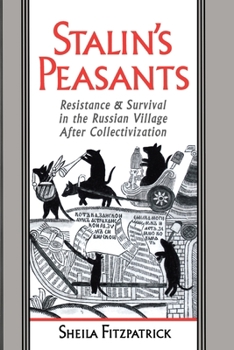Stalin's Peasants: Resistance and Survival in the Russian Village After Collectivization
Select Format
Select Condition 
Book Overview
Drawing on newly-opened Soviet archives, especially the letters of complaint and petition with which peasants deluged the Soviet authorities in the 1930s, Stalin's Peasants analyzes peasants' strategies of resistance and survival in the new world of the collectivized village.
Stalin's Peasants is a story of struggle between transformationally-minded Communists and traditionally-minded peasants over the terms of collectivization--a struggle of...
Format:Paperback
Language:English
ISBN:0195104595
ISBN13:9780195104592
Release Date:January 1996
Publisher:Oxford University Press, USA
Length:416 Pages
Weight:1.65 lbs.
Dimensions:1.1" x 6.1" x 9.3"
Customer Reviews
3 ratings
Peasants into Soviets?
Published by Thriftbooks.com User , 18 years ago
Sheila Fitzpatrick's study begins with the advent of collectivization in 1929 and covers the decade of the 1930's to the German invasion of June 1941. Fitzpatrick argues the peasants reacted to Stalin's brutal policy, what they regarded as "a second serfdom" (p. 4), with varying degrees of passive resistance. The author concludes that by the end of the decade, peasants, justifiable embittered and angered over the policy, did not approve or conform to collectivization as the states had intended it to be, but rather, "modified the kolkhoz (collective farm) so that it fit their own purposes as well as the state's" (p. 4). According to Fitzpatrick, by the end of the 1930's, "similar cultural patterns of resistance and adaptation" had spread throughout rural Russia despite well-entrenched ethnic and cultural ways of life. Fitzpatrick clearly shows why, in the summer of 1941, many peasants consequently regarded the invading Germans as liberators to the repressive Stalin regime. The author also explains how the initial decade of collectivization differentiated from the "kolkhoz amalgamations" of the post war period. Utilizing a narrative approach, Fitzpatrick provides us with nearly every aspect of life within the peasant village while simultaneously presenting a balance of political imagery from the Soviet regime. This combination of predominately social and cultural history along with an easily flowing narrative is what makes Fitzpatrick a leading scholar of this genre. The focus on the peasant village itself is what sets this study apart from other similar works. From Fitzpatrick's pages, we learn that the peasant village was not as united an entity around an earthly neighborly bond as one would suspect. In fact, the typical village was deceivingly factious. These animosities based on class are deeply rooted in the Emancipation (1861) and Stolypin (1905) reforms and, are perhaps exhibited best in the long-standing resentments between the Bedniaks and Kulaks. Stalin's systematic dekulakization demonstrated the threat the latter posed to the state's exploitive machinations and, as Fitzpatrick clearly shows, undermined the egalitarian objectives of collectivization. Nor, were the majority of peasants typically uneducated. This aspect is revealed in the numerous letters of peasant grievances culled from various archival depositories and delightfully reproduced within the pages of Fitzpatrick's work. Moreover, the theme of education is further illustrated by what is perhaps the most positive reform to emerge from collectivization: the rapid growth of rural schools. Fitzpatrick succeeds in differentiating between the social and cultural realities of the peasant village and the regimes propagandist illusions of the regime's ideal kolkhoz (Potemkin village). These differentiations in status played a significant role in the form of resistance the members of the peasant village chose to incorporate. Fitzpatrick gleans from a ric
Excellent social history of rural Soviet life in the '30's
Published by Thriftbooks.com User , 20 years ago
Stalin's Peasants is the pre-cursor to Fitzgerald's "Everyday Stalinism". While the focus of the later is soviet urban life the focus here falls squarely on the agrarian Soviet Union in the 1930's. This is an eye-opening look at the effect of collectivization at the village level. The famine of the early '30's- not the main focus- is shown to have been more the case of poor planning, beauracratic ineptitude and peasant reactions against collectivization rather than a diabolical program of systematic starvation. Post Soviet studies into the Stalinist era confirm the fact that non-party and non-technocratic wrokers who were not Kulaks were much safer from the pograms raging around them. The effect of this was that Kholhozes were constantly replacing managers and technicians caught up in the latest round up of wreckers, this in turn led to confusion and declining morale among the peasants. The peasants are contrasted with the urban vanguards who flooded the rural kholhoz's who were filled with communist fervor. These vanguards were resented and looked down upon as interlopers and outsiders by the local farm workers. Fitzgerald does great work showing how peasants retained their religious beliefs in the face of communist pressure and their passive resistance to constant pressures from the central government to accomodate the latest decrees.Just as in Everyday Stalinism, Fitzgerald's work here is excellent. This isn't for the novice reader but a great resource for those who are already knowledgeable on the Soviet Union in the 1930's.
Life as it really was - interesting lesson
Published by Thriftbooks.com User , 22 years ago
Fitzpatrick presents a view of Soviet collective farms that many of us may have guessed at, but never really knew or understood. As an amateur researcher of the former Soviet Union and now Russia, particularly the rural and agricultural sectors, I found the book to be very intriguing. It lays out the precursors to and development of the collective system. Provides insight and commentary on political decisions affecting and resulting from the same. And throughout, manages to allow a glimpse into what really happened from the vantage point of the people on the farms themselves - how they managed to survive despite living under a system so flawed as to almost be designed to see them fail.If you don't mind a long history and political science lesson, I highly recommend this book.





